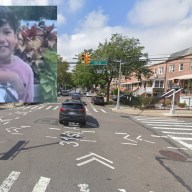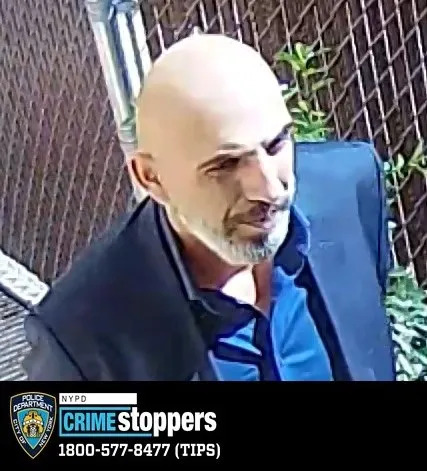By Helen Klein
One planned change to the toll plaza on the Staten Island side of the Verrazano-Narrows Bridge may indicate that Brooklynites’ dream of two-way toll collection returning to the span is a pipe dream indeed. In a press conference held on the Staten Island side of the bridge, officials with MTA Bridges and Tunnels announced that the agency plans to dismantle the unused toll booths adjacent to the Brooklyn-bound lanes, in order to reconfigure the toll plaza – a move that had Staten Island Borough President James Molinaro chortling, “This is the death of the two way toll.” Not so fast, said Joyce Mulvaney, an agency spokesperson. While, she noted, there are no current plans to restore the two-way toll, “The removal of the eastbound toll booths does not preclude bringing back two-way tolling,” she told this paper. “The booths are obsolete in their current state.” Indeed, Mulvaney pointed out, in the agency’s next capital plan, the in-use westbound tollbooths will be revamped. “As Lee Sander (the agency’s executive director and chief executive officer) said, it’s a blank slate right now,” Mulvaney went on. “It’s at the design stage and we are keeping everybody in the loop.” Besides removing the tollbooths, the project announced by the MTA will include the re-alignment of the eastbound roadway, which has been plagued by weaving vehicles. “Removing these unused eastbound booths and re-engineering the roadway for normal speed is a major feature of a modernization package that will ultimately produce a more efficient and safer travel corridor,” Sanders noted when the project was unveiled. City Councilmember Vincent Gentile agreed that the toll plaza’s current configuration needs a revamping. “It is an absolute, chaotic mess,” noted Gentile. “Imagine going through the toll plaza and trying to go onto the expressway and all of a sudden someone, driving at 60 miles per hour, is coming from your side, also trying to get onto the expressway. Whoever designed it should win the knucklehead award of the century,” he averred. The entrances and exits on the Brooklyn side should also be studied, said Representative Vito Fossella, “To see if there is an opportunity to make additional improvements. For the first time in decades,” he noted, “the MTA is finally making the type of improvements and investments that are needed to help solve our traffic problems.” The planned removal of the tollbooths did not unduly disturb Brooklyn activists. Bob Cassara, the president of the Bay Ridge Community Council (BRCC) and a longtime advocate of the Gowanus Tunnel, said that, in his view, the unused tollbooths, “Do slow down traffic and are probably dangerous. You get guys flying through there at 30 or 40 miles per hour, so it doesn’t take much to have an accident. They probably should have been taken down a long time ago.” With respect to the issue of the two-way toll, Cassara said, “Let’s give them the benefit of the doubt. Maybe they will put in some sort of high-speed tolling. Now, they are losing millions and millions of dollars by having the tolls in one direction. “High-speed tolling in both directions is really what’s needed,” Cassara added, not only to bring in more revenue, but also to help reduce traffic backups on the Brooklyn side of the bridge. Having tolls in only one direction, said Brian Kassenbrock, a member of Community Board 10, “Has created a very difficult flow of traffic. It has created a traffic nightmare not only in Brooklyn, not only on the Gowanus Expressway, but in Staten Island, where it’s rush hour plus in the morning everyday because of the truck traffic. So I think it’s in everybody’s interests to reconsider the issue,” Kassenbrock went on. “The toll system has really skewed the traffic in ways that have had an unfortunate impact on both Brooklyn and Staten Island.” Cassara agreed. The free ride into Brooklyn, he said, encourages truckers to go over Staten Island instead of taking the George Washington Bridge, even if they are headed to the Bronx. “All you need is a 10 to 20 percent reduction in traffic,” he said, “to balance it out and make life easier. There will be a lot less pollution for Staten Island as well.” Gentile expressed disappointment that the press conference was held in Staten Island with little notice given to elected officials or community activists invited to attend. “They notified us late yesterday for an 11 a.m. meeting I couldn’t make,” Gentile said on the day of the event. “They told us just to send somebody. That’s outrageous treatment by the MTA. I am demanding that they have a Brooklyn meeting for Brooklyn community people and elected officials on the Brooklyn side of the bridge.” Indeed, said Mulvaney, the agency would be “happy” to hold a briefing in Brooklyn. “We apologize to everyone,” she said. “No one was intended to be shut out.” Besides the reconfiguration of the toll plaza, the project will include the rehabilitation and realignment of three eastbound ramps – the entrance/exit at Lily Pond Avenue, the entrance at Father Capodanno Boulevard and the South Narrows entrance – and the rehabilitation and realignment of four westbound ramps – the Lily Pond Avenue exit, the North Narrows exit, the westbound Staten Island Expressway on-ramp at Lincoln Place, and the Bay Street exit. Finally, MTA will “partner with” the state Department of Transportation (NYSDOT) to rehabilitate the Fingerboard Road bridge. Construction is expected to occur between 2010 and 2014. According to the MTA, traffic going through the toll plaza has gone up 20 percent in the past two decades. The Verrazano Bridge carried a whopping 70 million vehicles in 2006.

































